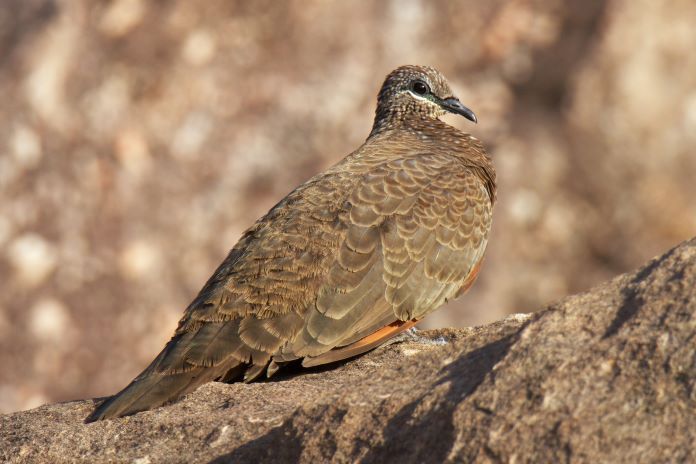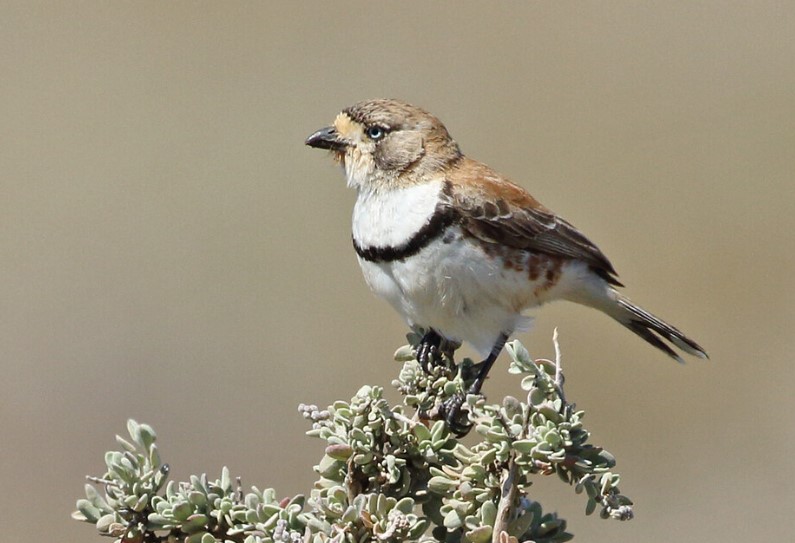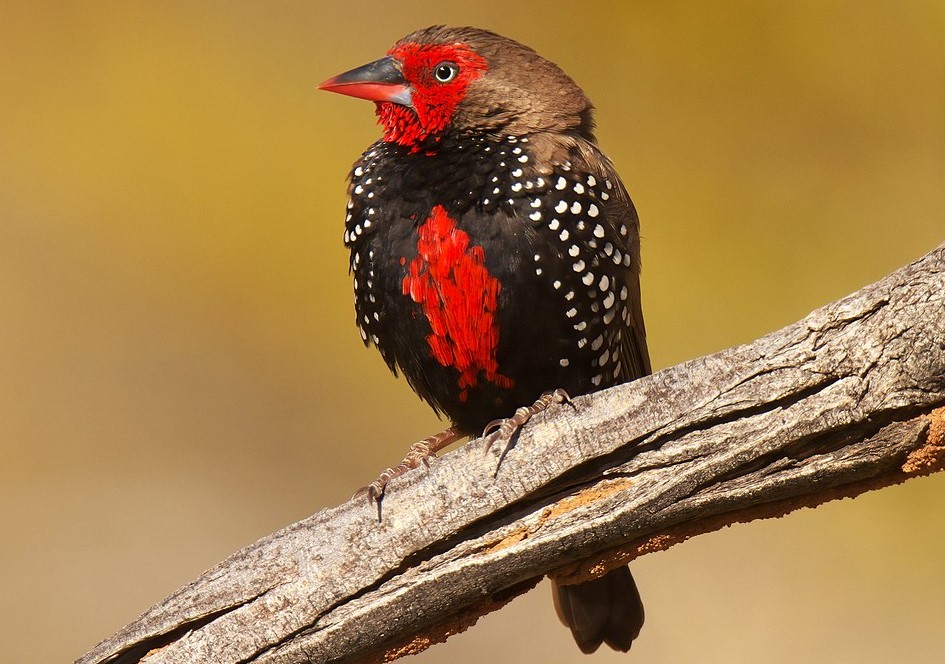Family: The chestnut-quilled rock pigeon (Petrophassa rufipennis) is a species of bird in the family Columbidae.
Habitats: The escarpment of the Western Arnhem land rises abruptly from the plain, and at its base are tumbled blocks of fallen sandstone. Some are as large as houses. Among the rocks grow pockets of trees and shrubs, and wherever there is soil, there is spinifex, other grasses, and herbs. The chestnut-quilled rock pigeon lives among these sandstone blocks and on the cliffs above, seldom venturing more than 100 meters out into the plain woodland that spreads from the base of the escarpment. This rock pigeon is very similar in behavior and habitat to the white-quilled rock pigeon, possesses a unique jizz, and is restricted to the sandstone regions of Arnhem Land and Kakadu.
Identification: Both adult sexes are similar. The head, face, and neck are dark brown, marked with large pale grey spots, and the lores are dusky. The rest of the upper parts are duskier mottled with lighter brown scalloping; the upper side of the tail is dusky. Wings are dark brown with a large chestnut patch in primaries. Throat very pale brown; white line under eye; breast as back; belly dusky. The eyes are dark brown. Bill black. Feet purple-brown. The immature bird is a little duller than an adult. However, the down is sandy to yellow.

Behaviour: Chestnut-quilled Rock pigeons live in pairs or parties of about 5 to 20 individuals. They keep strictly to the rocks or cliff faces, never perching in trees. During the hottest part of the day, the birds seek refuge in the shade, in fissures in the cliff face, on narrow ledges, or beneath sandstone blocks at the cliff foot.
Some even lie in holes scratched in moist soil far under rocks that rise little more than 200 millimeters above the surface of the ground. The birds fly almost vertically up a cliff face, but otherwise seldom fly more than three meters above the surface of the rocks, skimming over them and running as they touch down on landing. The birds drink at dusk and also at intervals during the day. When approaching the water, soak at the base of a cliff or, occasionally, in a pool in a stony creek.
They usually land on a rock some distance away or on a cliff ledge high above and pause before moving to the water’s edge. At any disturbance, they tend to freeze and squat before flushing, if at all. Although rock pigeons are members of the bronzewing group, their bowing display is distinctive. The male lowers his head and inclines his body forward until his breast touches the rock; he can move only slightly because he has very short legs. He spreads but does not lift his tail, splaying the feathers down onto the rock instead.
He partly spreads and raises his wings but does not tilt them forward; there is no shining bronze patch to display. Rather, he displays his plumage by raising the feathers on his back. Such a bow is usually repeated several times, each lasting about one-and-a-half seconds, often while the male is chasing the female. It is a display used both in courtship and aggression. In defense of the nest, the responding bird crouches and raises its wings.
Diet: Chestnut-quilled Rock pigeons forage actively in the early morning and late afternoon. When feeding, they run with considerable agility over, around, and under the rocks, or fly out to the flat ground away from the cliff. If disturbed, they immediately fly back to cover. They eat the seeds of a variety of grasses and herbs, as well as some trees and shrubs. Legumes may be more common in their diet than grasses, and they are not known to eat green leaves or insects. Although chestnut-quilled rock pigeons walk a great deal, they also fly from place to place when feeding, alternating bursts of rapid wing beats with gliding on down-swept wings. As they take off, their wings clap loudly, but otherwise, their descent from a cliff is typically a glide.
Other Names: This is also known as Rock Pigeon. The genus is commonly associated with tropical sandstone escarpments, as indicated by the popular name “rock pigeon.”
Size: Chestnut-quilled rock pigeon measures about 280–310 mm in length, has a wingspan of 138–155 mm, bill measuring 11.0 to 14.5 mm, and weighs between 135 and 180 grams
Vocalizations: Chestnut-quilled rock pigeon call is a coo-ca rook, two to five syllabic, on the same pitch; soft, conversational coos from birds feeding among the rocks; at the low point of bowing, display a harsh coo.
Nesting and Breeding: Chestnut-quilled rock pigeon nesting and breeding occur in March–September, during the dry season. Nest a thick base of sticks, and on it, a pad of spinifex leaves and stems, 25 mm thick and 230 mm in diameter, depressed into a saucer, placed on a ground rock in deep-shaded ledges and crevices.
Eggs: This rock pigeon lays two eggs, smooth, glossy cream-white, ellipsoidal, 26–27 x 22 mm (measured from 16 eggs of captive birds). The incubation period is about 16–18 days for both sexes. Young fledge in about 21–22 days.
Distribution: Chestnut-quilled rock pigeon is, as far as is known, restricted to the western escarpment of Arnhem Land from the vicinity of Oenpelli to Katherine Gorge.
Races: There are no races.
Read More: Feral Pigeon







